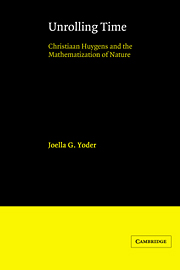Summary
Any attempt to reconstruct the process by which a great mind discovered an important concept becomes itself a process of discovery, and the recounting of the reconstruction becomes a mystery tale twice told. The detritus of the subject's activities – the calculations in the margins, the remains of former values poking out from behind ink blotches – these are the clues left to the historical detective. Shall I tell you of the manuscript that had to exist, although there was no trace of it in the collected works, simply because the derivation it contained was the “logical” next step? Eureka, I found it – or rather he did.
It is incumbent upon me to explain the way that I present the evidence gathered during my pursuit of the elusive Chr. Huygens. For obvious reasons I have adhered as much as possible to his original derivations and avoided the finished propositions. I have rarely presented his arguments verbatim, however, and this raises the possibility that I have misinterpreted what is on the page. In particular, for the sake of rendering the arguments more accessible, I have made some concessions to readability. Modern notation for such entities as pi and the equal sign are introduced, except in one case where I wish to make a point regarding the notation. A potentially more serious substitution is my use of algebraic notation in geometric arguments. Huygens stated everything verbally when he was in his “geometric mode” and used symbols such as the radical sign only when he switched to his “algebraic mode.”
- Type
- Chapter
- Information
- Unrolling TimeChristiaan Huygens and the Mathematization of Nature, pp. ix - xiiPublisher: Cambridge University PressPrint publication year: 1989



